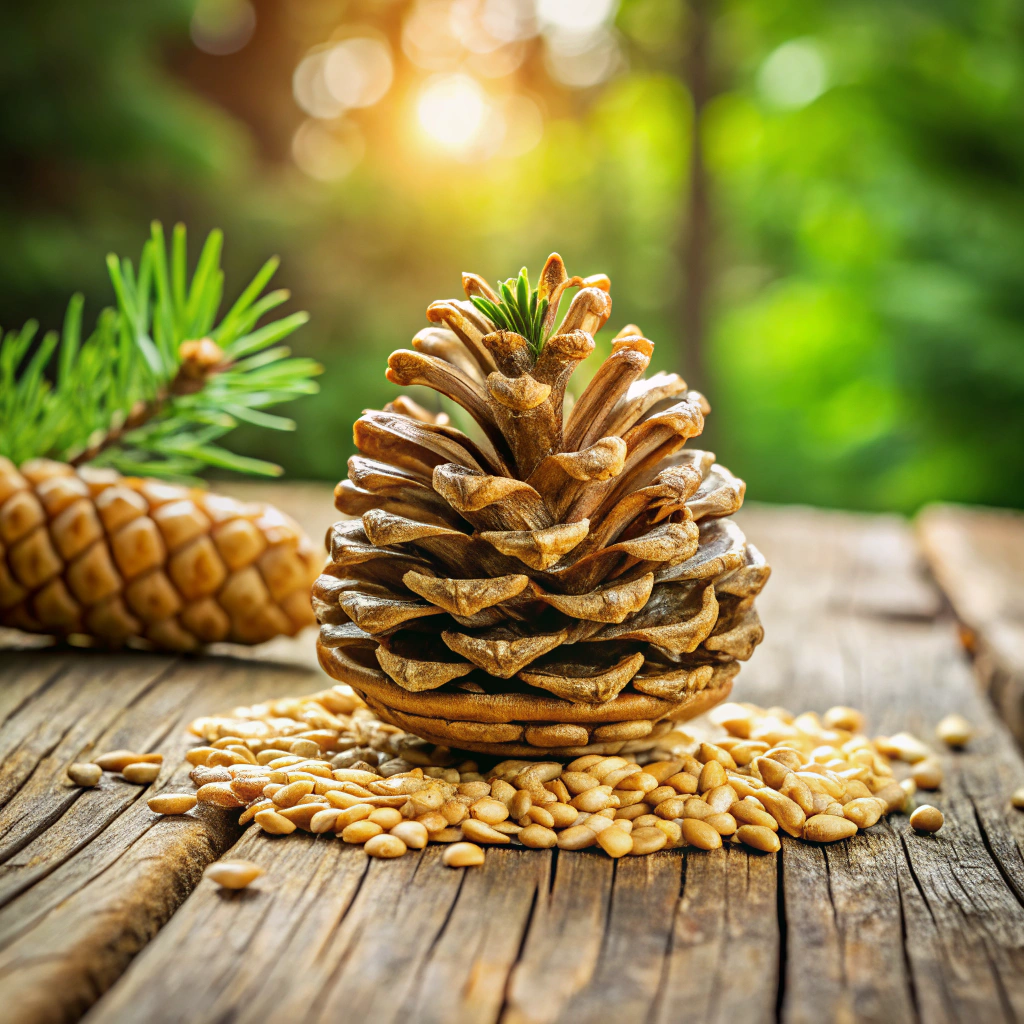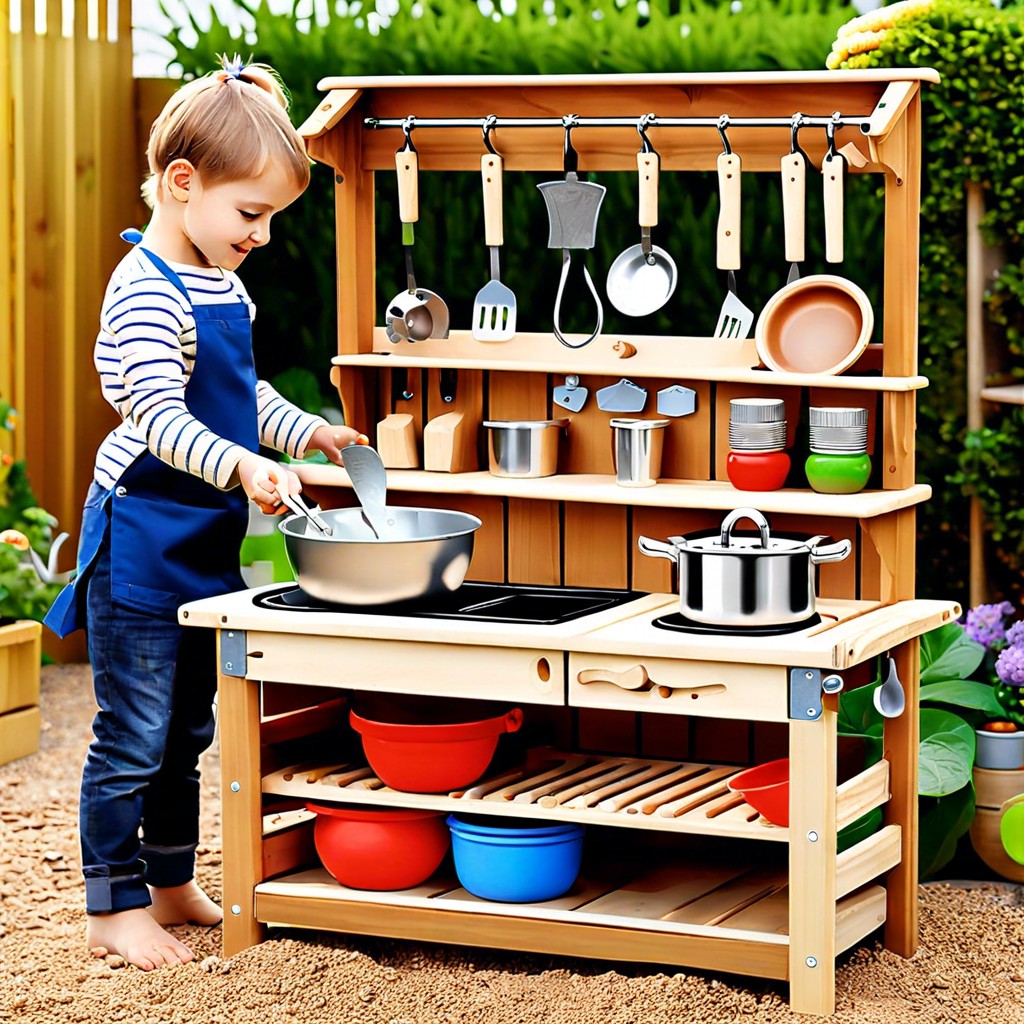Last updated on
Discover the ideal locations for installing vents in your outdoor kitchen to ensure proper ventilation, safety, and efficiency.
Outdoor kitchens are becoming increasingly popular these days, and for good reason. They allow you to enjoy the beautiful outdoors while cooking up a storm for your family and friends.
However, when designing an outdoor kitchen, it’s important to consider all the details that make it functional and comfortable to use. One of these details is where to put vents on your outdoor kitchen.
In this article, we’ll explore the importance of proper ventilation in an outdoor kitchen and provide some tips on where to place vents for optimal performance. So if you’re planning on building or renovating your outdoor cooking space, read on!
What's Inside
Importance of Ventilation in Outdoor Kitchens

Proper ventilation is crucial in any kitchen, and outdoor kitchens are no exception. Without adequate ventilation, smoke, heat, and moisture can build up quickly inside the cooking area.
This can lead to discomfort for those using the space as well as potential safety hazards such as fire or carbon monoxide poisoning.
In an outdoor kitchen setting where there are no walls or ceilings to contain smoke and fumes from cooking appliances like grills or smokers; proper venting becomes even more critical. Ventilation helps remove these harmful elements from your food preparation area while also keeping you comfortable by reducing heat buildup.
Moreover, good air circulation ensures that your appliances work efficiently by preventing overheating which could cause damage over time. Properly installed vents will help keep your outdoor kitchen clean too – they prevent grease buildup on surfaces which makes cleaning a breeze!
Identifying Ventilation Needs
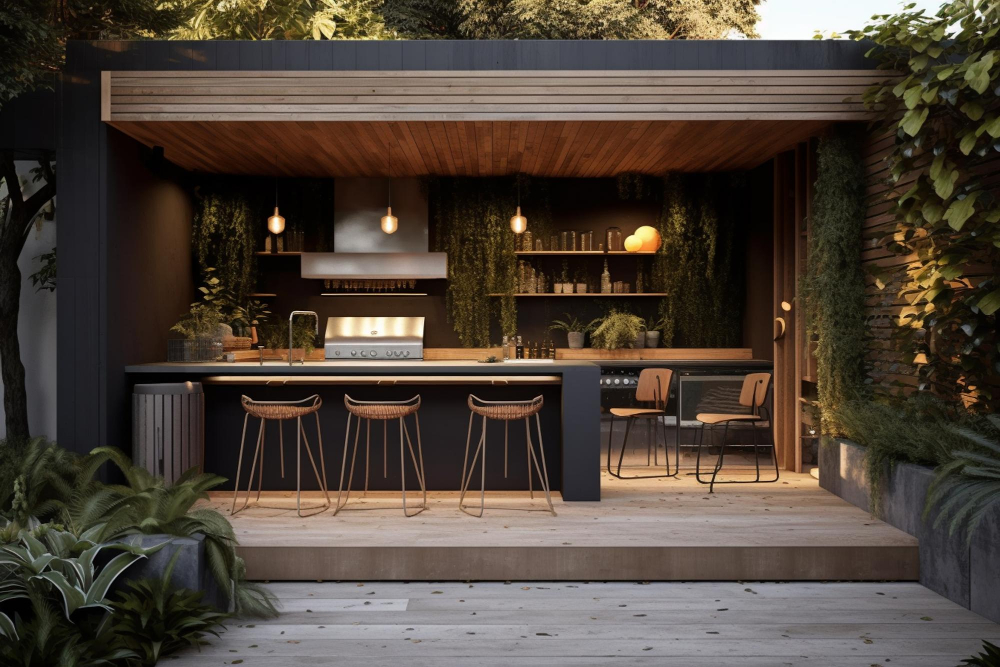
Proper ventilation is crucial for maintaining a safe and comfortable cooking environment. Without adequate airflow, smoke and fumes can accumulate quickly, making it difficult to breathe and potentially causing health hazards.
To determine the right type of venting system for your outdoor kitchen, consider factors such as the size of the space, how often you cook outdoors, what types of appliances you use most frequently (grill vs smoker), whether or not there are any enclosed areas within the space that require additional ventilation (such as cabinets or storage spaces), and local building codes.
By taking these factors into account when identifying your ventilation needs early on in the design process will help ensure that proper air circulation is achieved throughout all areas of your outdoor kitchen.
Proper Vent Placement
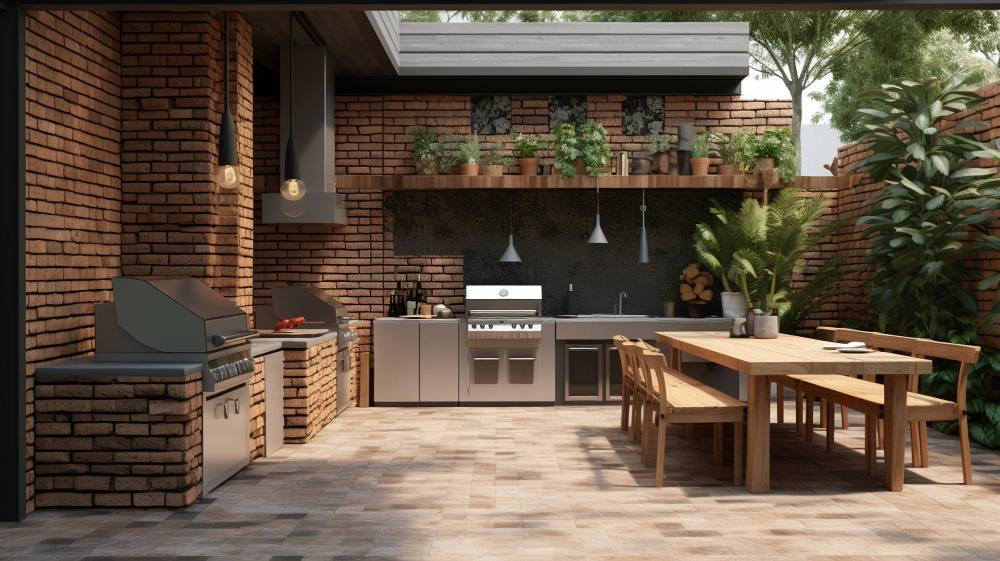
First and foremost, you want to ensure that the vents are placed in areas where smoke and fumes can escape easily. This means placing them near cooking surfaces such as grills or stovetops.
Another important consideration is the direction of prevailing winds in your area. You don’t want your vents blowing smoke directly into your neighbor’s yard or back into your own living space.
Consider installing vents on opposite sides of the outdoor kitchen so that air can flow freely through the space.
It’s also essential to think about how much ventilation you need based on the size of your outdoor kitchen and how often you plan on using it for cooking purposes. A larger grill or smoker will require more ventilation than a small gas range.
Lastly, keep safety codes in mind when deciding where to place vents for optimal performance while ensuring compliance with local building regulations regarding fire hazards caused by improper venting systems installation.
Ideal Vent Placement for Outdoor Kitchens

First and foremost, you want to ensure that the vents are positioned in such a way as to provide adequate ventilation for your cooking area. This means placing them strategically so that they can effectively remove smoke, steam, and other airborne particles from the space.
One of the most common locations for vents is above or behind your grill or cooktop. This allows smoke and heat generated by these appliances to be quickly removed from the area before it has a chance to build up.
Another important consideration when determining ideal vent placement is wind direction. You’ll want your vents positioned so that they’re not directly facing prevailing winds which could blow smoke back into your face while cooking.
If you have an enclosed outdoor kitchen with walls or cabinets surrounding it on all sides (or even just one), you may need additional ventilation options beyond those placed near appliances like grills and cooktops. In this case, consider installing ceiling fans or wall-mounted exhaust fans at strategic points throughout the space.
Vent Types for Outdoor Kitchens
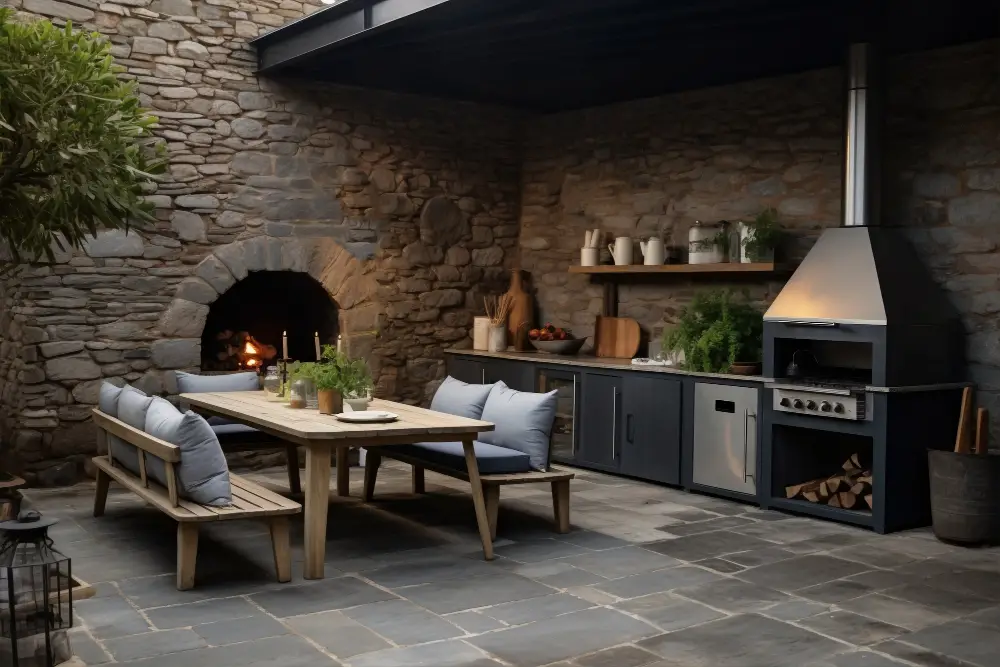
The most common types of vents used in outdoor kitchens include wall-mounted vents, roof-mounted vents, and downdraft vents.
Wall-mounted Vents: These are installed on an exterior wall near the cooking area and work by drawing smoke and fumes out through a duct that runs outside. Wall-mounted vents can be either horizontal or vertical depending on your preference.
Roof-Mounted Vents: As their name suggests, these types of ventilation systems are mounted on the roof above the cooking area. They work by pulling smoke up through a duct that leads to an exhaust fan located at the top of your home’s roofline.
Downdraft Vents: Downdraft ventilation is another option for outdoor kitchens where traditional venting may not be possible due to space constraints or aesthetic considerations. This type of system pulls air down into a vent located behind or beside your cooktop before exhausting it outside via ductwork underfoot level.
Vent Size Considerations
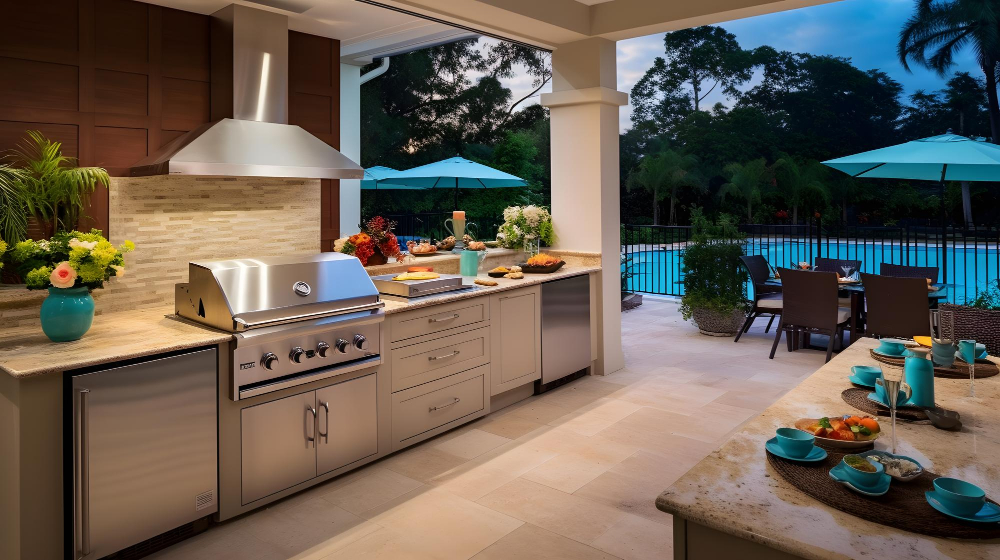
The size of the vents in your outdoor kitchen should be proportional to the overall size of your cooking area and the amount of heat and smoke generated by your appliances. If you have a small outdoor kitchen with only one or two burners, then smaller vents may suffice.
However, if you have a larger space with multiple grills and smokers running simultaneously, then larger vents will be necessary.
It’s also important to consider how much clearance is needed between the top of your grill or smoker and any overhead structures such as pergolas or roofs. This clearance will determine how tall your vent hood needs to be in order for it to function properly.
Another factor that affects vent sizing is wind conditions in your area. Strong winds can interfere with proper ventilation by blowing smoke back into the cooking area instead of drawing it out through the vents.
In windy areas, taller hoods may help prevent this problem.
Cabinets and Storage Ventilation
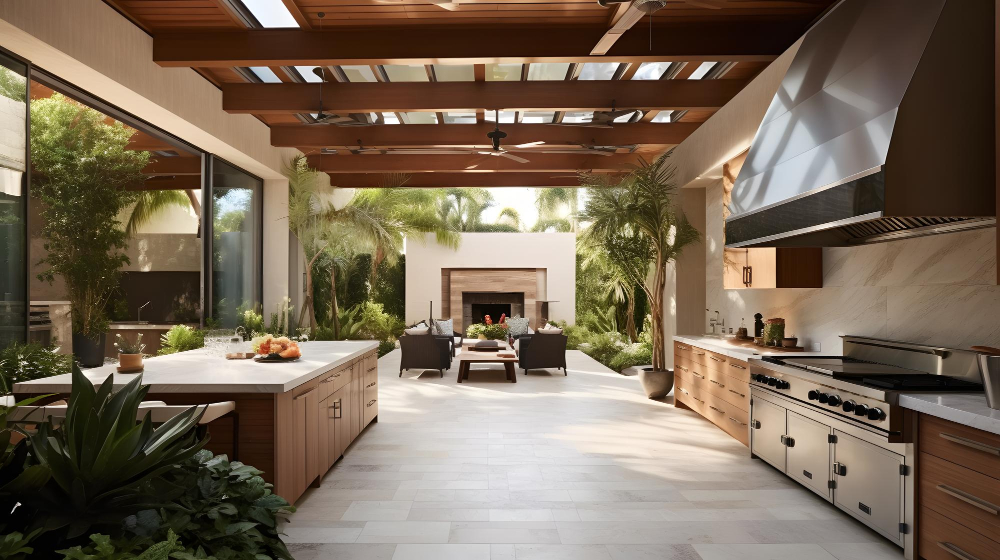
Proper ventilation will help prevent moisture buildup, which can lead to mold growth or damage to your cabinetry. It also helps keep stored items fresh by allowing air circulation.
To ensure proper cabinet and storage ventilation in your outdoor kitchen, you should install vents at the top and bottom of each cabinet unit. This allows for a continuous flow of air throughout the space.
If you plan on storing any flammable materials such as propane tanks or cleaning supplies in your cabinets or drawers, it’s crucial that they are properly ventilated. Flammable materials need adequate airflow around them to prevent combustion.
Don’t overlook the importance of proper cabinet and storage ventilation when planning out your outdoor kitchen design.
Grill Ventilation Tips
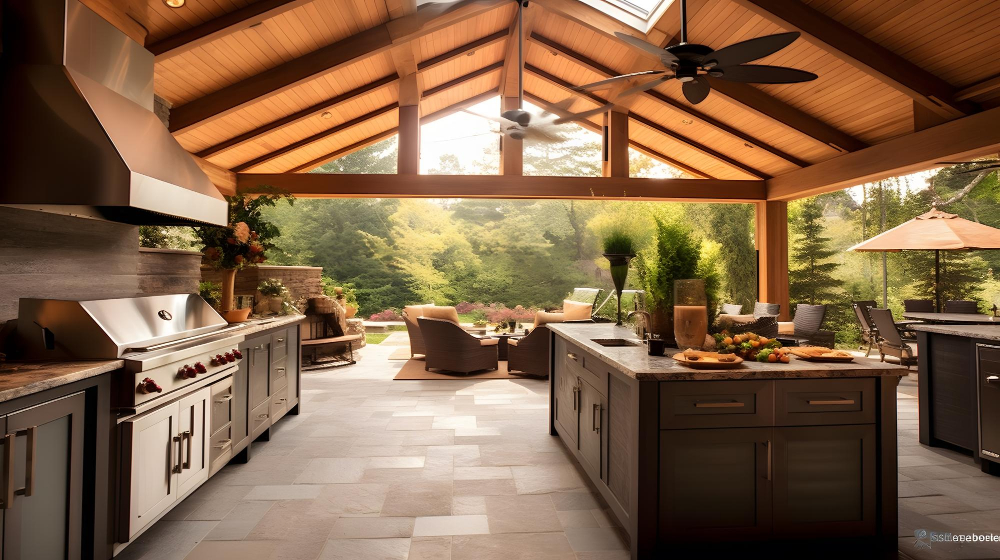
Grills can produce a lot of smoke and fumes that need to be properly ventilated. Here are some grill ventilation tips to keep in mind when designing your outdoor kitchen:
1. Position the grill away from walls or other structures: This will help prevent smoke and fumes from getting trapped in enclosed spaces.
2. Install vents near the grill: Consider placing vents on either side of the grill or directly above it to ensure proper air circulation.
3. Use an exhaust hood: An exhaust hood installed over your grill can effectively capture smoke and fumes before they spread throughout your outdoor kitchen.
4. Choose a vent with enough CFM (cubic feet per minute) rating: Make sure you select a vent with adequate power based on the size of your cooking area and type of appliances used.
Exhaust Hood Installation
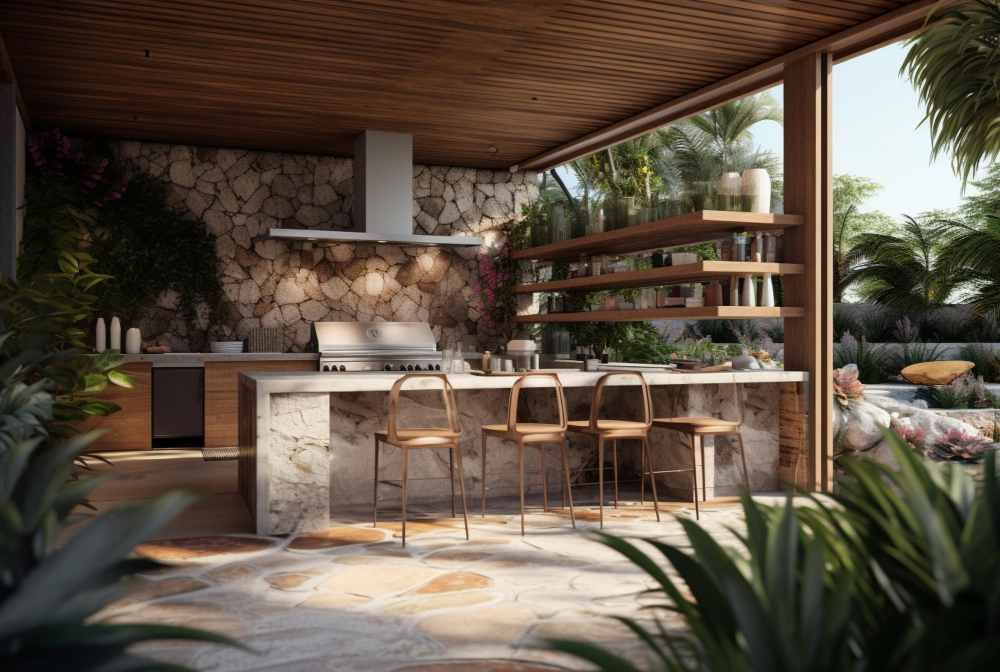
It helps to remove smoke, steam, and cooking odors from the air while also preventing grease buildup on surfaces. When installing an exhaust hood in your outdoor kitchen, it’s important to consider its placement carefully.
The ideal location for an exhaust hood is directly above the grill or cooktop area. This ensures that smoke and fumes are captured at their source before they have a chance to spread throughout the space.
The size of your grill or cooktop will determine how large your exhaust hood needs to be.
When installing an exhaust hood in your outdoor kitchen, you’ll need to ensure that it’s properly vented outside of the space using ductwork. This will require cutting a hole through any walls or ceilings as necessary and running ducts through them.
It’s important not only for proper ventilation but also safety reasons that you follow all building codes when installing vents in enclosed spaces like covered patios with roofs over them.
Ventilation for Outdoor Appliances
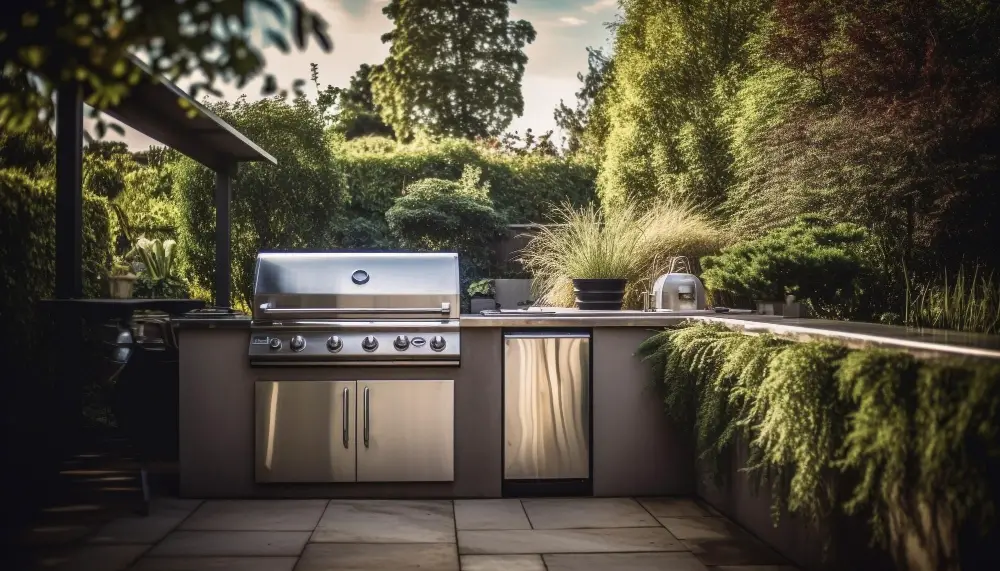
Grills, smokers, pizza ovens, and other outdoor cooking appliances produce smoke and heat that need to be properly ventilated for safety reasons. In addition to ensuring proper air circulation in your cooking area, adequate ventilation can also help prevent damage caused by moisture buildup.
Each appliance has its own specific requirements when it comes to venting. For example:
- Grills: Most grills require a hood or exhaust fan installed above them for proper ventilation.
- Smokers: These devices typically have vents on both the top and bottom of the unit that allow smoke to escape while regulating temperature.
- Pizza Ovens: Depending on whether they are wood-fired or gas-powered ovens will determine their venting needs.
It’s essential always check with manufacturers’ instructions before installing any appliance in your outdoor kitchen as each one may have different specifications regarding placement of vents.
Smoke Management Solutions
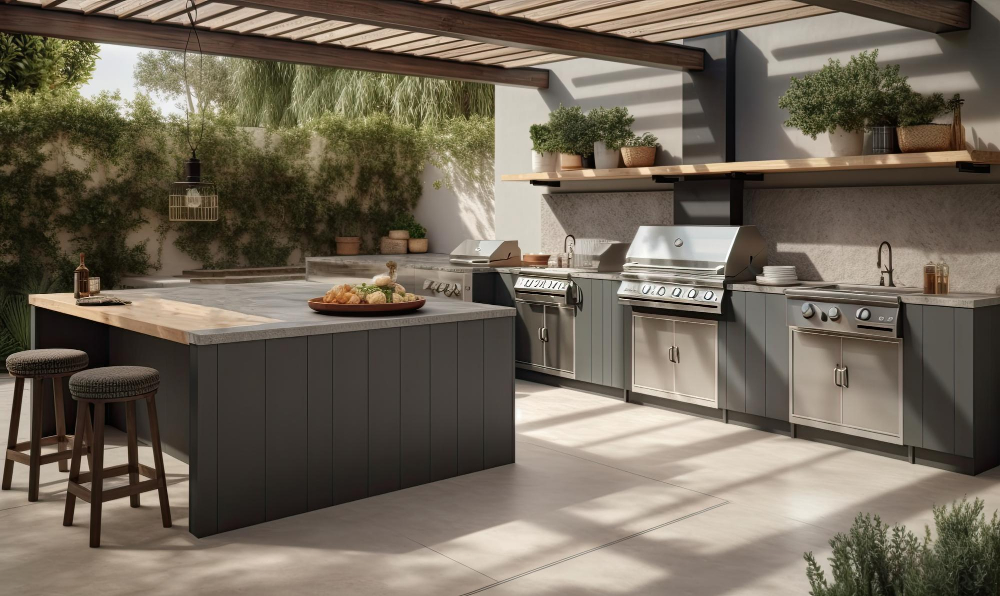
Smoke can be a nuisance to your guests and neighbors, and it can also pose health risks if inhaled excessively. Fortunately, there are several smoke management solutions that you can incorporate into your outdoor kitchen design.
One effective solution is to install an exhaust hood above the cooking area. This will help capture smoke before it has a chance to escape into the surrounding areas.
Make sure that the hood is properly sized for your grill or cooktop and installed at an appropriate height above them.
Another option is to use natural ventilation by placing vents strategically around the perimeter of your outdoor kitchen space. This allows fresh air in while pushing out any unwanted smoke or fumes from cooking appliances.
If you have an enclosed space like a gazebo or pergola where you plan on installing your outdoor kitchen, consider adding ceiling fans with built-in ventilation systems as they help circulate air more efficiently than traditional fans while keeping pesky bugs away from food preparation areas.
Lastly, using wood chips instead of charcoal briquettes when grilling reduces harmful emissions significantly since wood burns cleaner than charcoal does.
Venting Materials and Styles
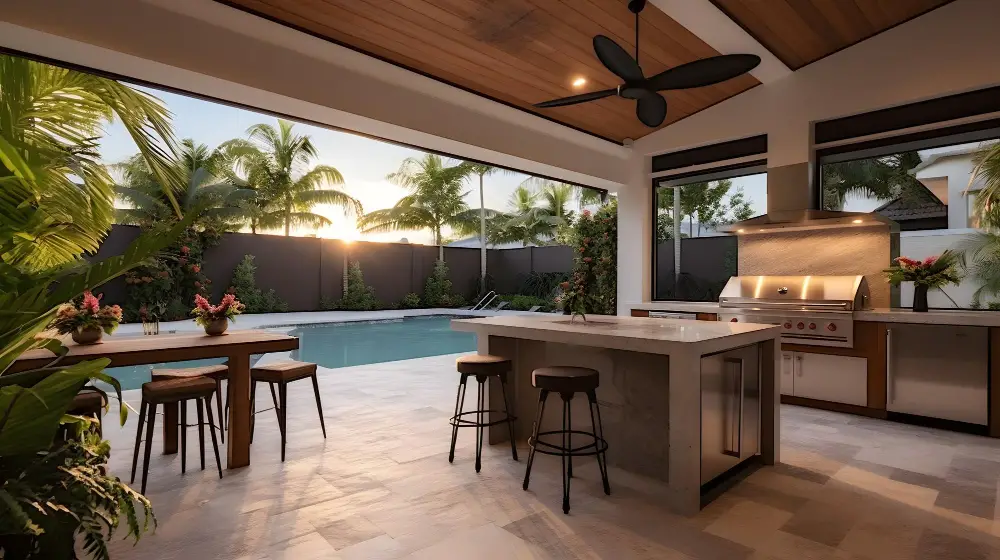
The most common materials used for vents include stainless steel, copper, and aluminum. Stainless steel is the most popular choice due to its durability and resistance to corrosion.
Copper is also a great option as it adds an elegant touch to your outdoor kitchen design.
In terms of vent styles, you can choose from wall-mounted or ceiling-mounted vents depending on the layout of your outdoor kitchen. Wall-mounted vents are ideal if you have limited space in your cooking area while ceiling-mounted ones work best if you have high ceilings or want a more seamless look.
Another style option that has become increasingly popular in recent years is hidden ventilation systems that blend seamlessly into cabinetry or other structures within the outdoor kitchen design.
Regardless of which material or style you choose for your venting system, make sure they meet safety standards set by local building codes before installation begins.
Aesthetic Alternatives to Visible Vents
Fortunately, there are several ways to incorporate ventilation into your outdoor kitchen without compromising its appearance.
One option is to install a downdraft vent system that sits flush with the countertop when not in use. This type of vent pulls smoke and fumes down through ductwork beneath the counter and out through an exterior wall or roof.
Another alternative is a pop-up vent that rises from behind or beside the cooktop when needed. These vents can be installed directly into countertops or cabinetry for a seamless look.
If you prefer natural materials like stone or brick for your outdoor kitchen, consider incorporating built-in air gaps between stones or bricks as part of your design. These gaps allow air to flow freely while maintaining visual continuity throughout your space.
If you’re looking for something truly unique, consider installing decorative grilles over traditional vents. Grilles come in various styles such as geometric patterns and floral designs that add character while still allowing proper airflow.
Safety and Building Codes

Proper ventilation not only ensures that your cooking area is comfortable and efficient but also helps prevent the buildup of harmful gases such as carbon monoxide. It’s important to note that building codes vary from state to state, so it’s essential to check with your local authorities before installing any vents in your outdoor kitchen.
In general, most building codes require a minimum distance between the vent hood and any combustible materials such as wood or vinyl siding. The National Fire Protection Association (NFPA) recommends at least 18 inches of clearance between the bottom of an exhaust hood and any combustible material.
Some states may require permits for installing vents in an outdoor kitchen or have specific regulations regarding vent size or placement. Failure to comply with these regulations can result in fines or even legal action if someone gets injured due to improper installation.
Ventilation Safety Considerations

Proper ventilation not only ensures that your cooking area is comfortable and efficient but also helps prevent dangerous situations such as gas buildup or fire hazards. To ensure the safety of your outdoor kitchen, there are several key considerations you need to keep in mind when installing vents.
Firstly, make sure that all venting components are made from high-quality materials and installed correctly by a professional if necessary. This will help prevent leaks or other issues that could compromise the integrity of your system.
Secondly, consider the location of any combustible materials near your vents such as wooden structures or plants. Make sure they’re at least three feet away from any heat sources like grills or burners.
Lastly, check with local building codes to ensure compliance with regulations regarding vent placement and installation requirements for outdoor kitchens in your area.
DIY Vent Installation Steps
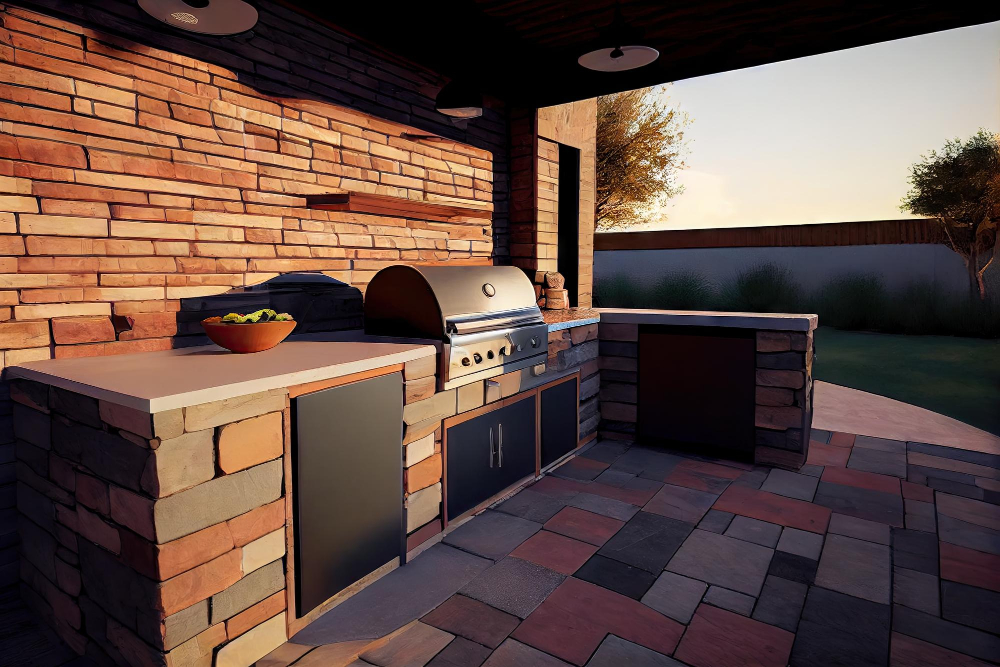
It’s important to follow the proper steps to ensure that your ventilation system is safe and effective. Here are some basic steps for installing vents in an outdoor kitchen:
1. Determine the location of the vent: Before you start cutting holes into walls or cabinets, decide where you want your vent to go based on our previous recommendations.
2. Measure and mark: Use measuring tape and a pencil to mark out where you will cut holes for both intake (low) and exhaust (high) vents.
3. Cut holes: Using appropriate tools such as jigsaw or reciprocating saws carefully cut through wall materials following manufacturer instructions if available.
4.Install ductwork : Connect flexible ducting from each hole with clamps ensuring they are tight enough not allowing air leaks.
5.Attach Vent Covers : Install covers over each opening using screws provided by manufacturer.
6.Test Your System : Turn on appliances one at time while checking airflow coming from both intake/exhaust openings making sure everything works properly before sealing up any gaps around edges of cover plates with silicone caulking.
How to Properly Install Vents in an Outdoor Kitchen
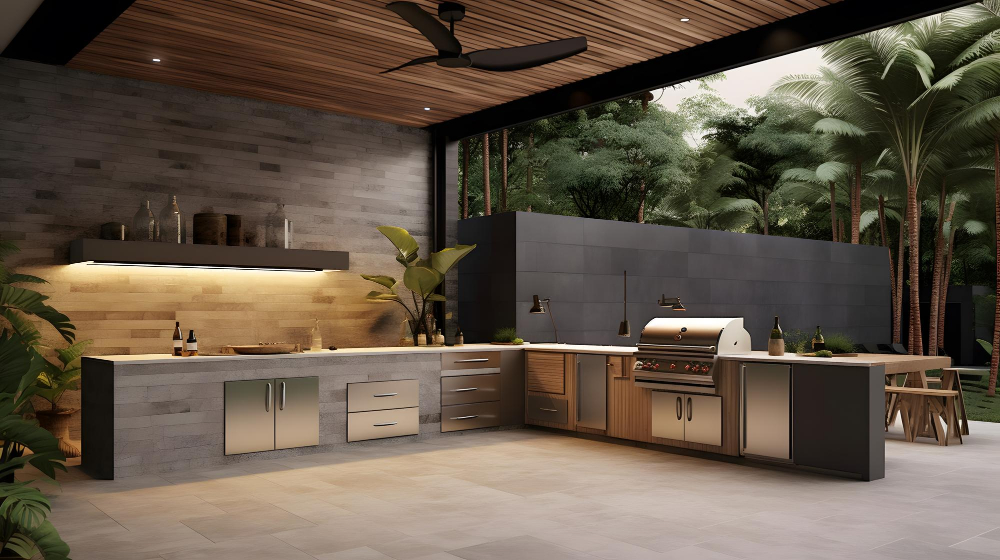
Here are some steps you can follow for a successful vent installation:
1. Determine the location: Before installing vents, identify where they should be placed based on your cooking equipment’s layout and ventilation needs.
2. Choose the right type of vent: There are different types of vents available, including wall-mounted or ceiling-mounted options, so choose one that suits your outdoor kitchen design.
3. Measure accurately: Take precise measurements before cutting any holes in walls or ceilings for proper placement.
4. Cut openings carefully: Use appropriate tools like jigsaws or reciprocating saws to cut through walls and ceilings without damaging them.
5. Install ductwork properly: Connect ductwork from each vent opening to an exhaust hood outside using metal pipes with insulation sleeves for safety reasons.
6. Seal all joints tightly with foil tape or mastic sealant around every connection point between ducts and hoods as well as at any other gaps where air could escape into unwanted areas such as attics or crawl spaces beneath floors above ground level.
Ventilation Maintenance

Proper ventilation maintenance ensures that your outdoor cooking space remains safe and efficient for years to come.
One of the most critical aspects of ventilation maintenance is cleaning. Over time, grease and debris can accumulate inside the vents, reducing their effectiveness or even causing a fire hazard.
To prevent this from happening, make sure to clean your vents regularly using a stiff brush or compressed air.
Another essential aspect of ventilation maintenance is inspecting the vent covers for damage or wear and tear. Damaged vent covers can allow pests like insects and rodents into your outdoor kitchen while also compromising proper airflow.
If you notice any unusual smells coming from your outdoor kitchen when cooking with the hood on or see smoke escaping through gaps around ductwork connections during use – it may be time for professional inspection by an HVAC technician who specializes in exhaust systems servicing.
Efficient Air Circulation Tactics
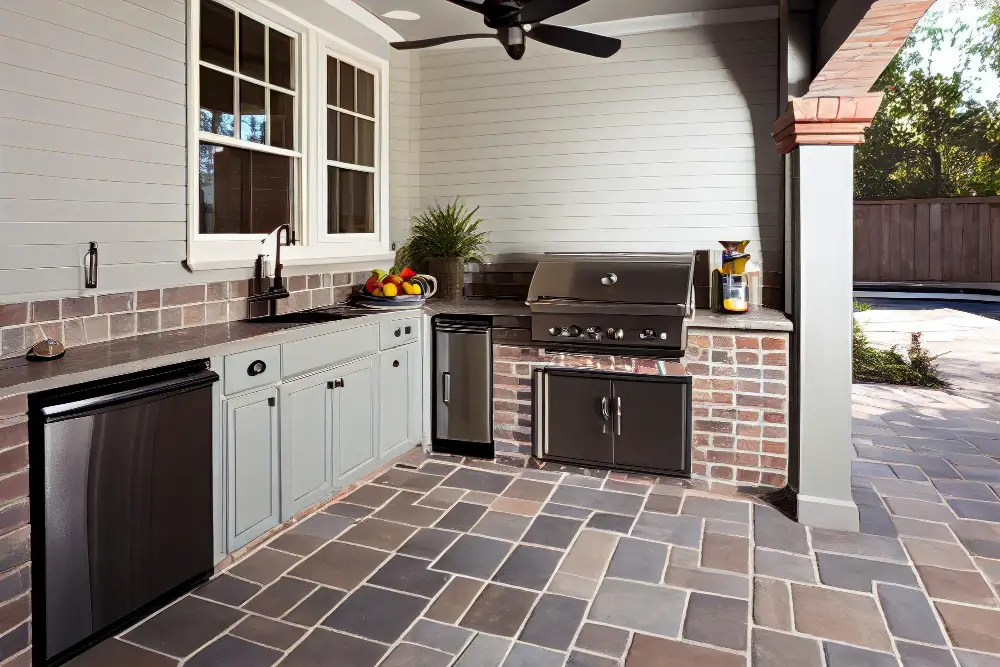
Efficient air circulation can also make a big difference in how well your outdoor kitchen performs. Here are some tips on how to improve air circulation in your outdoor cooking space:
1. Use ceiling fans: Installing ceiling fans above your seating area or dining table can help circulate the air and keep you cool during hot summer days.
2. Position appliances strategically: Place grills, smokers, and other heat-producing appliances away from seating areas or enclosed spaces to prevent smoke buildup.
3. Install windows or doors with screens: Adding screened windows or doors allows fresh air into the space while keeping bugs out.
4. Consider adding an exhaust hood: An exhaust hood over your grill helps remove smoke and odors from the cooking area quickly.
5. Keep clutter at bay: Cluttered countertops obstruct airflow around appliances; therefore, ensure that there is enough counter space for food preparation without blocking vents’ paths.
Ventilation for Enclosed Spaces

If your outdoor kitchen is enclosed, proper ventilation becomes even more critical. Enclosed spaces can trap smoke and fumes from cooking appliances, leading to poor air quality and potential health hazards.
To ensure adequate ventilation in enclosed spaces, consider installing a range hood or exhaust fan above your grill or cooktop. These devices will help remove smoke and fumes from the area while also improving air circulation.
Another option for ventilating an enclosed outdoor kitchen is through natural airflow methods such as windows or vents installed on opposite walls of the space. This allows fresh air to enter while pushing out stale indoor air.
Regardless of how you choose to ventilate your enclosed outdoor kitchen, it’s essential that you prioritize safety by following building codes and manufacturer recommendations for appliance placement and venting requirements. With proper planning and installation techniques in place, you can enjoy a safe environment with excellent airflow throughout your entire cooking area!
FAQ
Does an outdoor kitchen need vents?
An outdoor kitchen requires vents if installed under a covered structure; however, it does not need vents if it is in the open air and uncovered.
Where should vents be placed in BBQ Island?
Vents should be placed at the bottom of the BBQ Island, as propane is denser than air and tends to sink, which prevents the buildup of propane gas.
Do you need a vent for an outdoor grill?
Yes, a vent is required for an outdoor grill to ensure safety and proper ventilation in the outdoor kitchen area.
Do built in grills need to be vented?
Yes, built-in grills need to be vented, with natural gas venting high up and propane gas venting low to the ground for safe gas escape.
What are the best types of vents to use for an outdoor kitchen?
The best types of vents to use for an outdoor kitchen are weather-resistant vents such as stainless steel and motorized vents.
How can you determine the optimal number of vents for an outdoor kitchen setup?
To determine the optimal number of vents for an outdoor kitchen setup, consult local building codes and ventilation guidelines, taking into account the size and layout of the space.
Are there specific building codes or guidelines to follow when installing vents in an outdoor kitchen?
Yes, specific building codes and guidelines must be followed when installing vents in an outdoor kitchen to ensure safety and proper ventilation.
